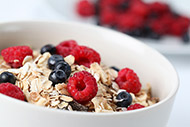
A high-sugar breakfast can cause a spike in blood sugar that is followed by a drop in blood sugar. This creates a roller coaster ride of hunger, carbohydrate cravings, and decreased energy levels.
High-sugar breakfasts may include:
- Sugary cereals
- Donuts
- Sweet rolls
- Pancakes or waffles with syrup
Does that mean you can never eat these items? Of course not. But to reduce hunger, aim for a nutrient-rich breakfast that keeps you feeling full longer (high satiety). Including fiber, fat, and protein in your meal can slow the release of glucose into the blood, allowing an appropriate insulin release. This increases the overall satiety of the meal — keeping you full longer.
High fiber, complex carbohydrates (such as whole grains) have low glycemic loads, and they are packed with vitamins and minerals. Eating these healthy carbohydrates in combination with healthy fats and lean protein further improves the satiety of the meal. For instance, choose whole-grain toast with a slice of low-fat cheese or a whole-wheat waffle with fruit spread or almond butter.
Also, try varying the size of your breakfast. For example, you may find that increasing the amount of food eaten at breakfast and balancing this out by decreasing the amount of food eaten at dinner more closely matches your hunger profile.
Experiment with various combinations until you find a variety of meals that provide you with satiety for a few hours. Remember, being hungry 3 to 5 hours after eating is normal. Individuals vary in their sensitivity to blood sugar swings, so it may take time until you find which meals keep you feeling full the longest.



 3 Healthy Lunches for Your Work Week
3 Healthy Lunches for Your Work Week
 5 Tips for Stretching Your Budget for Healthy Food
5 Tips for Stretching Your Budget for Healthy Food
 Best Ways to Reduce Added Sugar
Best Ways to Reduce Added Sugar
 Healthy Tips to Lighten Up Picnic Foods
Healthy Tips to Lighten Up Picnic Foods
 Do You Need to Drink Milk?
Do You Need to Drink Milk?
 Tips to Keep Track of Water Intake
Tips to Keep Track of Water Intake
 Butter vs. Margarine: What’s the Best Choice?
Butter vs. Margarine: What’s the Best Choice?
 7 Good Mood Foods
7 Good Mood Foods

 Pinterest
Pinterest RSS Feed
RSS Feed